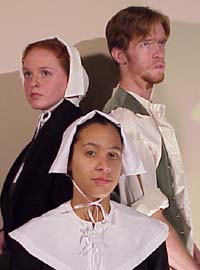The Crucible
by Arthur Miller
December 2, 3, 9 and 10, 2000
Cast:
| Betty Parris |
|
Dana Melashenko |
| Tituba |
|
Juelle James |
| Rev. Parris |
|
Ryan Deal |
| Abigail Williams |
|
Stephanie Binns |
| Susanna Wallcott |
|
Lindsay Lombard |
| Ann Putnam |
|
Cindy Gall |
| Thomas Putnam |
|
Nate Kay |
| Mercy Lewis |
|
Erica Sharp |
| Mary Warren |
|
Ryan Lunsford |
| John Proctor |
|
Adam Lombard |
| Rebecca Nurse |
|
Andrea Wolfing |
| Giles Corey |
|
Lorin Koch |
| Rev. Hale |
|
Jeremiah Burt |
| Elizabeth Proctor |
|
Betsy Harlan |
| Francis Nurse |
|
Bradley Nelson |
| Ezekiel Cheever |
|
Treye McKinney |
| John Willard |
|
Joshua Reinbold |
| Judge Hathorne |
|
Peter Schmidt |
| Deputy-Governor Danforth |
|
Jim Bock |
| Sarah Good |
|
Keri Donaldson |
| Hopkins |
|
Lance Ivy |


Crew:
| Co-Directors: |
|
Marilynn Loveless
Jim Bock |
| Assistant Director |
|
Peter Schmidt |
| Technical Director/Lighting Design |
|
Erich Dorzab |
| Sound Design |
|
Matt Nutter |
| Set Design |
|
Kristin Smith |
| Costume Design |
|
Alexia LeFore |
| Stage Manager |
|
Melissa Peckham |
| Properties |
|
Malcolm Mills |
| Floor Crew: |
|
LuAnn Venden Herrell
Kurt Dreschel |
| Set Construction: |
|
Erich Dorzab
Jeffrey Klam
Alexia LeFore
Malcolm Mills
Sean Mountain
Joshua Reinbold
Joshua Tomczek |
| Publicity |
|
Melisaa Peckham |
| House Manager |
|
Katrina Forgey |
| Box Office |
|
Doug Taylor |
| Ushers |
|
Jennifer Barton
Kelley Gillette
Sarah Stanley
Heidi Gruzinski |
| Costumes |
|
June Smith
Whitman College-Barbara Stone
Little Theatre-Patricia Wilson
Carmen Creek Clothing Co.-Kathleen Neal |
| Opening Night Gala Committee |
|
Julie Lorren (chairperson)
Dave and Anne Bullock
Bev Beem |
| Gala Decorations |
|
Joanie LeFore
Julie Lorren
Leah Patch
Trissa Gifford |
In February 1950, an obscure American senator from Wisconsin announced, "I have here in my hand a list of
205 known to be members of the Communist party and who, nevertheless are still working and shaping the policy
of the State Department." With Joseph R. McCarthy's speech, a dark chapter of American politics acquired its
leader and its name.
The House Committee on Un-American Activities (HUAC) became the breeding ground for a frenzied 'red
scare' that would see thousands of Americans lose their jobs, suffering ruined careers because of blacklisting in
their professions; many going to jail or into exile.
The reckless hunt for possible communist subversives in American society, without proof of guilt or adequate
safeguards for defense, continued to be a problem during the 1950s.
The Crucible was first presented by Kermit Bloomgarden at the Martin Beck Theatre, New York City,
on January 22, 1953. In 1955, Miller was called before HUAC and questioned about his links to the communist party.
He was astonished when people he had known for many years walked past without a nod of recognition, having
labeled him a "red" sympathizer.
That the play was not an immediate success should not have come as a great surprise. The parallels between
the hunt for "reds under the beds," in 1950 and witches in 1692, was not lost on his audience. Writing in 1958, Miller
recalls the initial response to his play:
I believe that on the night of its opening, a time when the gale from the Right was blowing at its fullest fury,
it inspired a part of its audience with an unsettling fear and partisanship which deflected the sight of the real and
inner theme, which ... was the handing over of conscience to another, be it woman, the state, or a terror, and the
realization that with conscience goes the person, the soul immortal, and the "name." That there was not one mention
of this process in any review, favorable or not, was the measure of my sense of defeat...
What happened in Massachusetts in 1692 was really quite simple. A group of teen-aged girls caused a brief
revolution. In January they were ordinary girls, taking orders from adults, working very hard in their homes,
listening to long sermons in church on Sundays and other days. By the spring of 1692 they held an enormous
amount of power--even the power of life and death--over a large number of the adult citizens of Massachusetts.
They had begun by accusing poor old women and slaves. But within a few weeks they were charging ministers,
merchants, and other solid citizens. The girls probably had no plan, at least not at the beginning. Still, they were
able to terrify tough old pioneer farmers. They were also able to use the power of the Massachusetts government
to send innocent men and women to the gallows.
Although the story appears extreme and the beliefs bizarre Miller claims that his account of the Salem witch
trials is tame compared to the actual court transcripts. What struck Miller as particularly frightening was the
"unrelieved, straight-forward, and absolute dedication to evil displayed by the judges of these trials and the prosecutors."
He goes on to say that he actually modified the trial dialogue, in order to make Danforth a "human being." In
retrospect he felt he was "wrong in mitigating the evil of this man and the judges he represents."
November
30 Collegian article
December 1 Review by
Sarita McCaw
Back
to Drama History Page
last modified 25 June 03 by Andrew Cockerham
Copyright © 2003 wwcdrama -- all
rights reserved

